Second class of postwar destroyers built for the Marine Nationale, the T53 were an improvement of the T47 (Surcouf class), only five being built before French developments on missiles led to La Galissonnière (1960), the initial 6th T53 (now T56), and the Suffren class GMDs. The T53 differed by having improved electronics and increase capabilities for tracking and controlling aircraft with an improved air search radar and relocated DRBI 10 height finder, plus increased ASW capability. They underwent modernizations in the 1960-70s, notably Duperré which was completely rebuilt and was active until 1992, the remainder until 1976-81.
Design of the class

The previous FS Surcouf, lead ship of the T47 class.
The T53 were started as a simple follow-up of the T47, keeping the same basic features, although improved mostly on the electronics front, with masts built differently. Both were lattice placed in front of their respective funnels. Otherwise, they kept the exact same hull, with same dimensions and features: A classic shape with rounded stern, forcastle, and main artillery placed in superfiring positions fore and aft. The only difference with WW2 ships was that the forward “B” mount was not a dual purpose 127mm (5-in) M1948 (compatible with US 5-in/38 rounds) but a twin 57 mm AA, with two more installed aft on the quarterdeck house. The Duperré was the 13th of a common “squadron escort” destroyer postwar design, on 16 ship mixing the very similar T47 and T53 classes. Se the T47 development for more.
Hull and general design
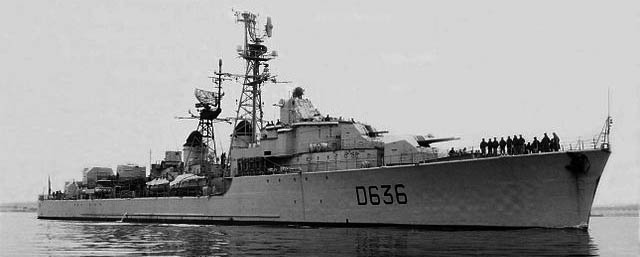
Tartu, official photo as completed (CC)
The hull being the same, the T53 had a displacement of 2,750 long tons (2,794 t) standard, 3,740 long tons (3,800 t) full load for a Length of 128.6 m (421 ft 11 in), Beam of 12.7 m (41 ft 8 in) and Draught of 5.4 m (17 ft 9 in). The hull was pre-fabricated and fully welded, made of 84 elements for 1,100 tonnes alone, divided into 17 waterproof compartments listed from A to Q, front to rear.
The superstructure bridge was low, given an enclosed and open bridge in front like late US WW2 destroyers. The main artillery telemeter was placed aft of it. Large wings going to the full beam were supported by X type pillars with “Brest” type lift raft strapped over.
A long uninterrupted superstructure as built aft of the forecastle down to the superfiring aft 5-in guns. The triple torpedo tubes banks (it seems four were initially planned, then deleted at completion) were located aft of the twin beam 57 mm AA mounts, with full traverse due to recesses. Depht charges racks and throwers were considered an obsolete tech and an ASW rocket launcher solution was retained instead. The prow was of the clipper still but with limited sheer, and the forecastle was straight, hull shapes were “full” down to the relatively broad poop, but with fine entry, a straightened beam “almond shape” also reminiscent of both US and British destroyers. The hull also featured a few portholes, on two levels forward mid-way on the forecastle and a few aft at the height of the TTs and ASWRL. Duperré’s hull will be completely rebuilt later.
Powerplant
The same powerplant was retained from the T47: Two propeller shafts (4 bladed props) were driven by two shafts, connected by gears to two sets of Parsons steam turbines each, so four in all, fed by the overheated steam (35 bars, 385°C.) produced by four Indret boilers, one for each turbines. The steam turbines were mounted in line and were of the low and high pressure types for economical cruise and efficience. Other ships could have the alternated Rateau Turbines, but still Indret boilers.
In, addition electric power was provided by two steam turbo alternateurs rated for 400 kW and two diesel Renault (then MGO) 180 kW backup alternators.
This powerplant generated a total of 63,000 shp (46,979 kW), and a top speed of 34 knots (63 km/h; 39 mph), for a range of 5,000 nmi (9,300 km; 5,800 mi) at 18 kn (33 km/h; 21 mph). This was equivalent to a Gearing class (4,500 nm at 20 kts). The normal top speed was 32 knots, but on trials they reached 36 kts with ease, 38 kts when overheating.
Armament
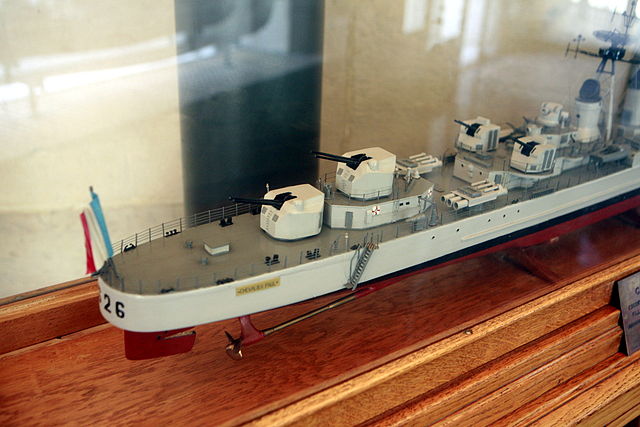
A model of the T47 Chevalier Paul, showing the two aft 127 mm/54 M48, 550 mm aft torpedo tube banks and two 57 mm AA mounts. The same configuration was retained for the T53 except for the ASWRL/fwd TTs swap.
It was relatively old school even for the 1950s, with its gun placement and emphasis (at first) on torpedo armament for antiship purposes, as initially they were to have four triple TT banks, mounted on the broadside aft in recesses to allow full traverse. Eventually for stability reasons, the forward pair of TTs was deleted in favor of the aft 324 mm ASW Rocket Launcher for stability.
Modifications over the years were important, see below. Duperré was completly rebuilt and partly rearmed.
Main: 3×2 127mm (5-in)/54 M48 Dual Purpose
Like the previous class, the Duperré relied on three twin M1948 5-in or 127mm/54 placed in axis fore and aft, one mount on deck forward, and two superfiring aft. This configuration was chosen for stability as the aft pair was one deck lower.
The Model 1948, 5 inches (127 mm)/54 used NATO and USN standard 5-in/38 ammunition, shared by numerous MDAP destroyers transferred to all nations but France and Britain. The three twin turrets recalled the Sumner/Gearing classes but they were noticeably smaller and more compact. This DP weapon of the Marine Nationale stayed a standard for half of the cold war, also shared by cruisers and destroyers and taking advantage of a cheap, massive stockpile of US-made 5-in ammunition. They were the first French first high-angle mountings, a dual-purpose development of the twin 130mm mounting seen on Le Hardi class destroyers built in 1940. These were not automated, and needed 11 personnel per gun, and were criticized as over complex, failing to meet requirements for the rate of fire and modified after entering service. Designed for 15 rpm, this was rather 12-13 in practice.
They fired the AAC Mark 41, HC Mark 41, Illum. Mark 48, HE Com Mark 42 or VT Mark 41 rounds averaging 69 Ibs (31 kgs) at 2,650 fps (808 mps), to a range of 24,060 yards (22,000 m) and AA Ceiling (85°) of 29,530 feet (9,000 m).
More on navweaps.
Secondary: 3×2 57mm(2.25-in)/60 M51 AA
Same congiguration as for the T47, with one mount superfiring forward, axial, two side mounts aft, with a great arc of fire for all. These were a Bofors water-cooled design used also by the Netherlands and the Swedish Navy. Bofors introduced this as a scaled up 40 mm/70 Model 1948. France adopted the 57 mm/60 (2.25″) Model 1951, and had loaders dropping individual rounds into ammunition boxes instead of clips, which fed quadrant-shaped hoppers mounted at the gun’s trunnions to enable gravity feed at all angles. The French Conseil Superieur decided to get rid of the 40 mm Bofors postwar as obsolete against modern aircraft. The M1951 were installed in French-designed twin turret. However their “shelf life” was short as in the late 1950s rapid jet development tech made them obsolete already. Rate of fire was 120 rounds per minute cyclic, range (45°) was 15,860 yards (13,000 m) and AA Ceiling 18,040 feet (5,500 m). French rounds had better performances than the Swedish ones. More on navweaps.
Light AA
As completed she ship still had two to four 20 mm Oerlikon AA guns, with two install on the bridge’s wings. Lotation of the other pair was closed to the aft FCS on sponsons of the rear superstructure platforms. More info.
Torpedo Tubes
So as said above, four triple banks were initially planned, with an aft pair and a forward pair, all at deck level on the broadside. The forward was deleted to allow the addition of an ASW rocket launcher, one main different with the previous T47. These triple banks (tailored for ASW warfare) were derived from those of WW2, except for the K2 or L3 torpedoes they fired. French torpedoes were rather larger than standard ones of a 533 mm (21 inches) caliber, at 550 mm (21.6 in), a traditional caliber for prewar French torpedoes.
K2 Torpedo: 1956 designed 2,433 lbs. (1,104 kg), 173 in (4.400 m) long model carrying a 617 lbs. (280 kg) HBX-3 or TNT warheard to 1,000 yards (900 m) at 50 knots, powered by an Oxygen-alcohol engine. Close to Weapon Alfa, British Limbo, Italian Menon.
L3 Torpedo: A 1960 designed 2,006 lbs. (910 kg), 170.1 in (4.320 m) model carrying a 440 lbs. (200 kg) Tolite A1 warhead, 5,500 yards (5,000 m)/25 knots powered by a Nickel-cadmium Battery. This was the new standard Acoustic-homing anti-submarine torpedo (600 manufactured).
More on navweaps
Bofors ASWRL
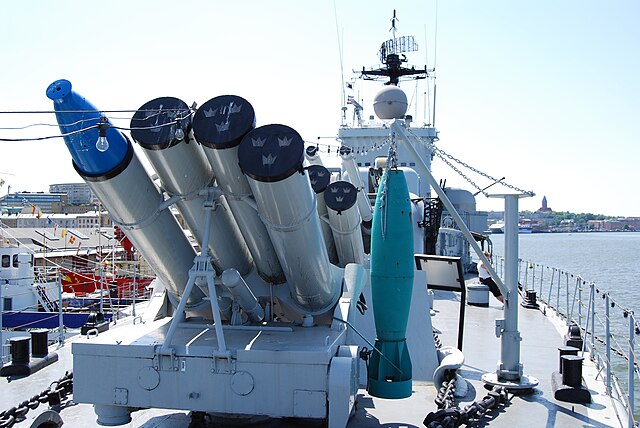
ASWRL on HMS Smalland.
Another Swedish-designed weapon aboard was the 324 mm anti-submarine rocket launcher, a postwar derivative of British and US Hedgehog types. The six-barrel 375 Bofors Mk 54 launched M/50 rockets (caliber 14.8 in) at 3,625 m (11,893 ft) range with a High explosive warhead using Acoustic Proximity Fuse for detonation.
On the T53 class, the model 1954 it was installed aft, on the axial superstructure with the two TT banks abeam. So the structure was enclosed unlike on the T47 class. The number of reloads carried is unknown. For this, the T53 coupled work with two sonars, DUBV and DUBA 1B. This French derivative was called modele 1954, measured 2.15 m for 302 kg and the mount elevated to +8° to 90° for a useful range of 3,100 m at 180 m/s. This system was retrofitted on the T47 after refit as well. See also (fr)
Sensors
The T53 featured a revised design, and the better capability for tracking and controlling aircraft came from the improved air search radar moved to the mainmast, and the DRBI-10 height-finder now installed on the foremast. The derrick masts supporting them were also reinforced but of similar design and location as for the T47.
DRBV31 surface sentry and navigation radar: Full archive description
2x DRBC30 fire control radars: Two “radars de conduite de tir DRBC-30” mounted forward dedicated to the 127mm guns and aft for the 57mm and setup for AA fire for the 127 mm mounts as well. Called télépointeurs (rangefinders) they were equipped with an optical telemeter.
DRBI10B altimetry radar: Height finding radar. No more info.
DRBV22A combined sentry radar: DRBV 22A (For “Détection Radioélectrique emBarquée de Veille”) operating in D-Band, long-range naval air search radar. Predessessor of the Jupiter series. Similar to the AN/SPS-6 and AN/SPS-12 radars but having two supporting stays for the feed horn.
DUBV/DUBA 1B sonars: For “sonar de veille (V) directif à haute fréquence/d’attaque (A) directif à haute fréquence” DUBA 1B. This was a combo between a high-frequency directional surveillance sonar and high-frequency directional attack sonar.

Conway’s profile
⚙ T53 specifications (as completed, 1957) |
|
| Displacement | 2,750t standard, 3,740t full load |
| Dimensions | 128.6 x 12.7 x 5.4 m (421 ft 11 in x (41 ft 8 in x 17 ft 9 in) |
| Propulsion | 2 shafts, 4 Geared turbines, 4 boilers, 63,000 hp (46,979 kW) |
| Speed | 34 knots (63 km/h; 39 mph) |
| Range | 5,000 nmi (9,300 km; 5,800 mi) at 18 kn (33 km/h; 21 mph) |
| Armament | 3×2 127 mm DP, 3×2 57 mm AA, 4× 20 mm, 1×6 Bofors 375 mm ASWRL, 2×3 550 mm TTs |
| Sensors | DRBV31 ASR, 2x DRBC30 FCR, DRBI10B AR, DRBV22A CSR, DUBV/SUBA 1B sonars |
| Crew | 347: 19 officers, 328 enlisted |
Modifications of the class:
In 1969-1971, Tartu, La Bourdonnais and Jauréguiberry received the SENIT-2 CCS system (Central Fire Control).
In 1973 Forbin had the upper 127mm/54 aft removed as well as the forward twin 57mm/60 and a helicopter deck was fitted aft (no hangar) for an ASW Alouette III helicopter.
Read More/Src
Books
Conway’s all the world’s fighting ships 1947-1995
Jean Moulin et Robert Dumas, Les Escorteurs d’escadre, Marines éditions Nantes 1997
Jean Meyer et Martine Acerra, Histoire de la marine française des origines à nos jours. Ouest-France 1994
Michel Vergé-Franceschi (dir.), Dictionnaire d’Histoire maritime. Robert Laffont, 2002
Alain Boulaire, La Marine française: De la Royale de Richelieu aux missions d’aujourd’hui, Quimper, Palantines Ed. 2011
Rémi Monaque, Une histoire de la marine de guerre française, Paris, Perrin Ed.
Links
netmarine.net jaureguiberry
netmarine.net duperre
netmarine.net duperre class
en.wikipedia.org T_53-class_destroyer
fr.wikipedia.org Classe_T_53
fr.wikipedia.org jaureguiberry
navypedia.org/ duperre class
eeforbin.fr/
Videos
P. Schoendoerffer’s book adapation on the Indochina war, sporting D637 Jaureguiberry.
Two part documentary (FR)
Model Kits
A few kits by Heller and Mehanotehnika to 1:400 src
Duperré complete rebuilt:
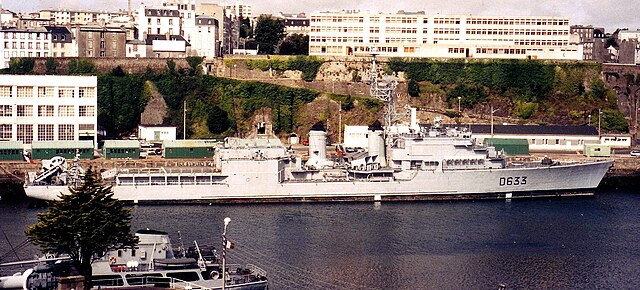
Duperré after decommission in 1990
The enormous differences between the basic T53 Duperré and the same after reconstruction and modernization in 1972 (src navypedia).
In 1973-74, Duperré had a complete rebuilding, quite radical in scope. The hull for example was lenghtened and provided with a pronounced straight clipper bow. She had rebuilt superstructures, with a more massive bridge, new single derrick formast with all sensors, rear beam-wide helicopter hangar, and aft landing deck, plus the poop modified with a recess to lay down the new VDS.
Armament and sensors were upgraded so she had four single MM38 Exocet SSM (4 MM38), one 100mm/55 Mod 1968 forward, two 550 mm torpedo catapults (for eight L5 torpedoes in reserve), one helicopter (model: Lynx ASW). Her new sensor suite consisted of the DRBV-22A, DRBV-51A, DRBC-51A radars, and the DUBV-23, DUBV-43 VDS (variable depth, towed array) sonars, plus for antimissile defence, two Syllex decoy rocket launchers and a SENIT-2 CCS suite, including jammers.
Later in the 1970s she received the new DRBC-32E radar and in the 1980s during her third modernization, her two Syllex decoy RL were removed and replaced by the new ARBR-16 ECM suite and two Corvus decoy RLs. She will be the object of a dedicated aticle in the future.
The case of La Galissonière:
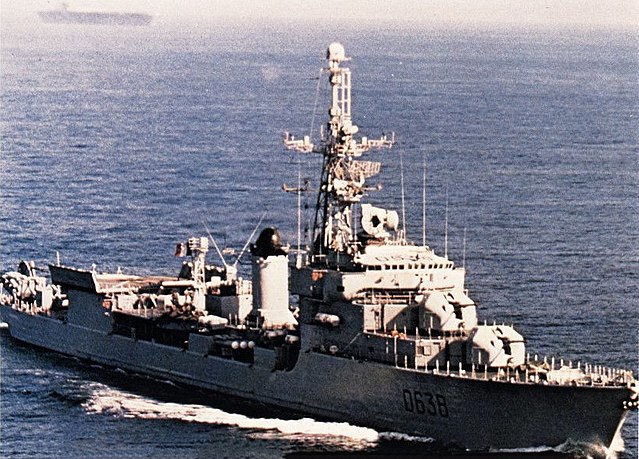
La Galissonière in 1983
The sixth ship and very last of 18 planned “squadron escorts” was entirely redesigned and rebuilt at the T56 variant. She was essentially a prototype for the Malafon: Specification were now 128 m (419 ft 11 in) in lenght overall, 12 m (39 ft 4 in) in beam, 5 m (16 ft 5 in) in draught, crew 272, a twin Model 1953 100 mm (4 in) gun, Malafon anti-submarine missile launcher (13 missiles), two triple 550 mm (21.7 in) torpedo tubes (2×3), a quadruple 305 mm (12 in) anti-submarine mortar, two 20 mm AA cannons and a hard and pad aft for an Alouette II or Alouette III helicopters. She will be the object of a dedicated aticle in the future.
 D633 Duperré
D633 Duperré
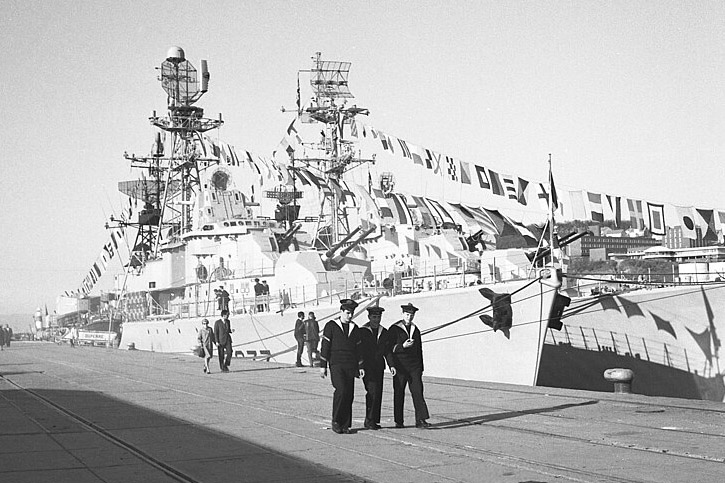
Duperré and Guépratte in Trondheim, 1965
Duperré (after Admiral Duperré (1775-1846)) was Laid down in Lorient, launched on June 23, 1956 and commissioned on October 8, 1957 in servuce until 1992 after two refits. She was used to test the design of the Cormoran 1 towed VDS (sonar) between 1967 and 1971. After her main refit in 1972 she hit a shoal in the Raz de Sein on January 12, 1978 at midnight. The rocks caused a 35-meter breach but there was no casualties. She was towed on January 13 to Brest arsenal for repairs.
 D634 La Bourdonnais
D634 La Bourdonnais
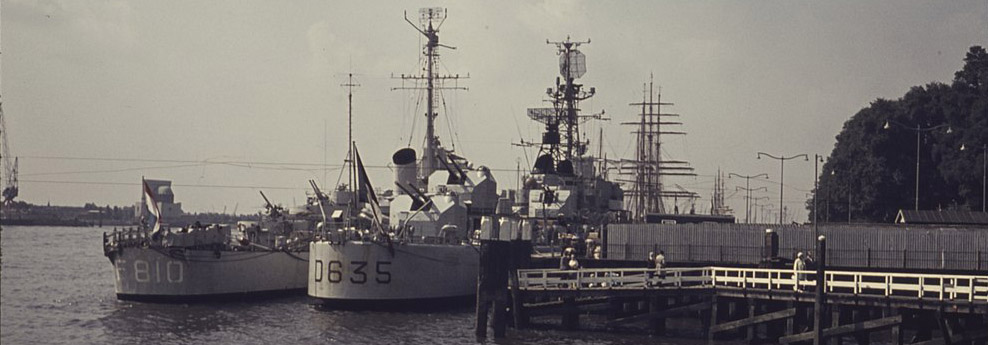
No photo of La Bourdonnais. This is the stern of D635 Forbin during a parade in the Netherlands, 1962
She was laid down in Brest on December 7, 1954 in dock 8, Laninon, next to Forbin and launched on October 15, 1955 completed on March 3, 1958.
In 1966 and 1968, La Bourdonnais participated in two missions in the Pacific Ocean with “Force Alpha” for the French nuclear testing campaigns. She was decommissioned on July 1976, and became hull Q577 in November 1977 for tests. She ended her days scuttled as breakwater at Ile Longue (French SSBN base), but later mothballed at Landévennec, then ended as target for the submarine Ouessant, which hit her with an Exocet SM39 missile in May 1992.
 D635 Forbin
D635 Forbin
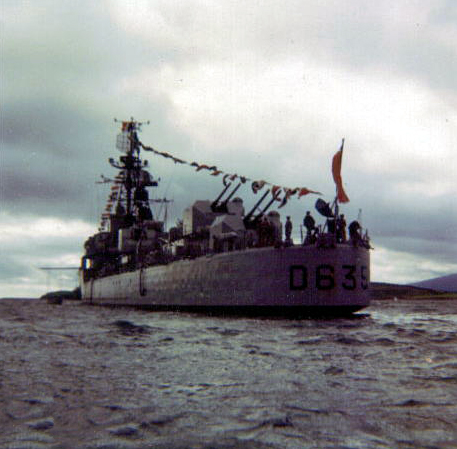
Forbin in Bantry Bay, 1970s
Like her sisters, Forbin was assigned the mission to escort and screen the aircraft carriers of the Clémenceau class included in the FY1953, FY1954 budget. They were an adaptation of the T47B design with priority mission being long-range aerial surveillance. Forbin (after 17th cent. Admiral Claude Forbin-Gardanne), sixth of the name, was laid down on 7 dec. 1954 at Brest Arsenal, Lanninon dock, launched on 15 octobre 1955, and commissioned on feb. 1958. Homeport was BREST, then TOULON (Medi Fleet), and back to BREST in 1973, Atlantic Fleet. She took part of the “light squadron”, then the DesRon 8, “Force Alfa” (Nuclear test Task Force), the DesRon 6, and lately the Marine Officiers school group.
She was modified from September 15, 1965 to make her suitable for nuclear tests campaigns in the Pacific with an enlarged bridge and reinforced waterproofing. She was modified again and rearmed on July 2, 1973 to serve as an escort for the helicopter cruiser Jeanne d’Arc, notably with an ASW helicopter platform, but also and student officer accommodation, so she could also take a school ship role. She was decommissioned on 1st june 1981, sold for BU.
 D636 Tartu
D636 Tartu
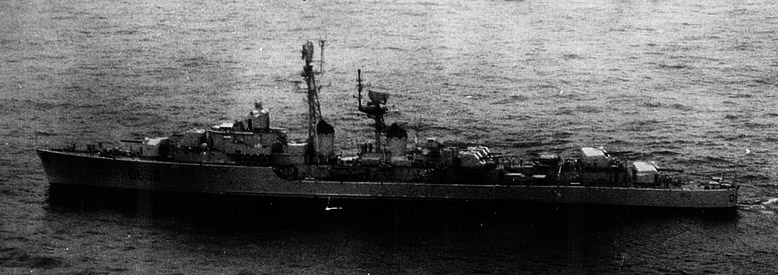
Tartu during the “Lobster war” with Brazil in 1963 (cropped)
Tartu was named after the Corsair Jean-François Tartu (1751-1793). She was built in Nantes Britanny shipyard, laid down on December 2, 1955, launched on February 5, 1958.
Tartu notably was flew over by Brazilian Air Force B-17s, having a prominent role during the 1963 “lobster war” between France and Brazil over fishery rights on the continental shelf. See the cold war Brazilian Navy for more. She saw service for twenty years, until decommissioned in December 1979. She was sunk as target on December 9, 1998.
 D637 Jaureguiberry
D637 Jaureguiberry
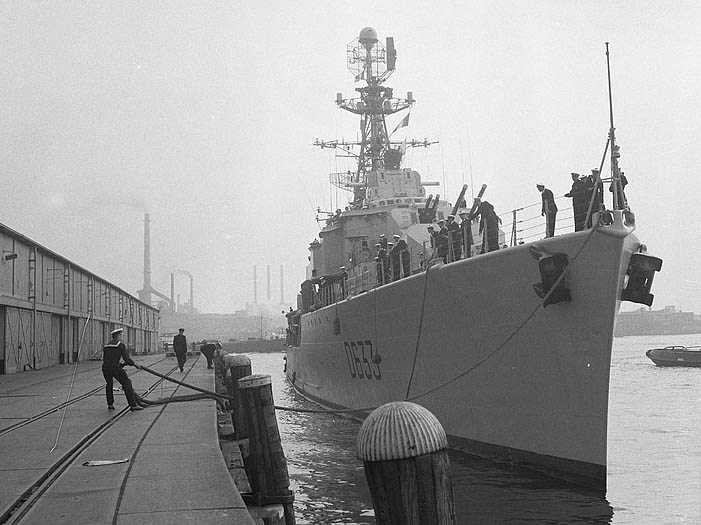
Unknown French destroyer in Amsterdam, possibly Jaureguiberry
Laid down in September 1954, Jaureguiberry (after admiral xxxx) was launched on 5 November 1955 and commissioned into the Marine Nationale on 15 July 1958 with the pennant D 637.
In 1966 and 1968, she took part in two nuclear tests, escorting “Force Alfa”, and a third in 1970 alongside with the cruiser De Grasse in the Pacific Ocean, which acted as HQ. In 1974, she achieved a long mission with Duquesne and at the start of 1977, a few months before decommission she took part in Pierre Schoendoerffer’s movie “Le Crabe-Tambour” on the Indochina war. She was decommissioned 16 September 1977, mothballed as hull No.Q580 and used as a target (ARMAT anti-radar missile tests) on 16 June 1982. She was sunk on 30 May 1986 as target by an Exocet MM40 missile.
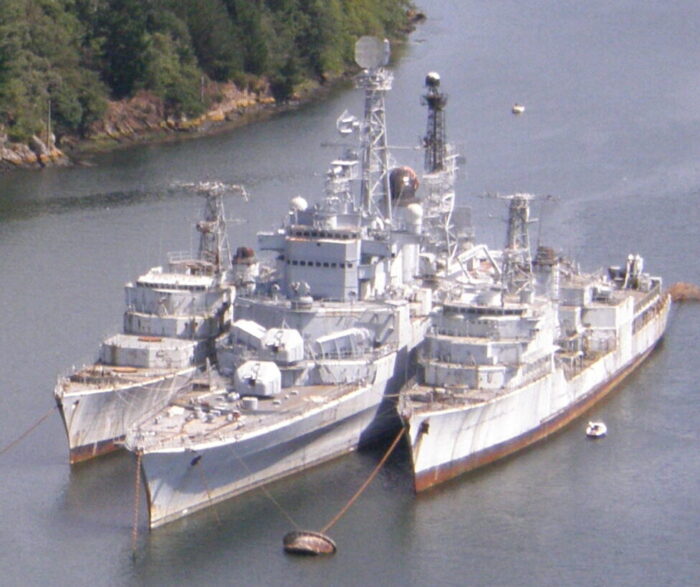
Stricken destroyers in Landevennec Fjord (Britanny) and Colbert in the 1990s, pending scrapping.

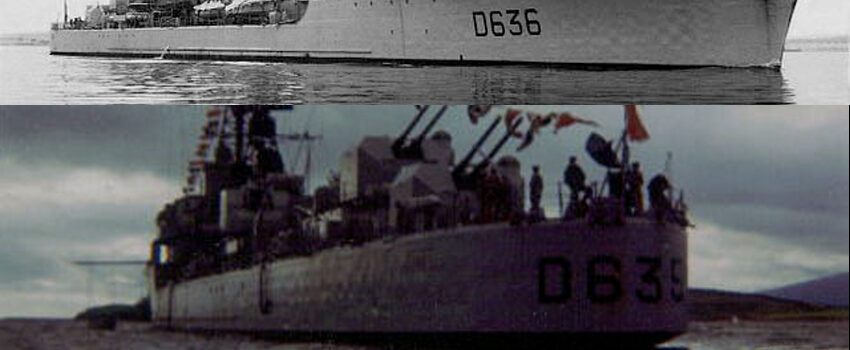


 Latest Facebook Entry -
Latest Facebook Entry -  X(Tweeter) Naval Encyclopedia's deck archive
X(Tweeter) Naval Encyclopedia's deck archive Instagram (@navalencyc)
Instagram (@navalencyc)





 French Navy
French Navy Royal Navy
Royal Navy Russian Navy
Russian Navy Armada Espanola
Armada Espanola Austrian Navy
Austrian Navy K.u.K. Kriegsmarine
K.u.K. Kriegsmarine Dansk Marine
Dansk Marine Nautiko Hellenon
Nautiko Hellenon Koninklije Marine 1870
Koninklije Marine 1870 Marinha do Brasil
Marinha do Brasil Osmanlı Donanması
Osmanlı Donanması Marina Do Peru
Marina Do Peru Marinha do Portugal
Marinha do Portugal Regia Marina 1870
Regia Marina 1870 Nihhon Kaigun 1870
Nihhon Kaigun 1870 Preußische Marine 1870
Preußische Marine 1870 Russkiy Flot 1870
Russkiy Flot 1870 Svenska marinen
Svenska marinen Søværnet
Søværnet Union Navy
Union Navy Confederate Navy
Confederate Navy Armada de Argentina
Armada de Argentina Imperial Chinese Navy
Imperial Chinese Navy Marinha do Portugal
Marinha do Portugal Mexico
Mexico Kaiserliche Marine
Kaiserliche Marine 1898 US Navy
1898 US Navy Sovietskiy Flot
Sovietskiy Flot Royal Canadian Navy
Royal Canadian Navy Royal Australian Navy
Royal Australian Navy RNZN Fleet
RNZN Fleet Chinese Navy 1937
Chinese Navy 1937 Kriegsmarine
Kriegsmarine Chilean Navy
Chilean Navy Danish Navy
Danish Navy Finnish Navy
Finnish Navy Hellenic Navy
Hellenic Navy Polish Navy
Polish Navy Romanian Navy
Romanian Navy Turkish Navy
Turkish Navy Royal Yugoslav Navy
Royal Yugoslav Navy Royal Thai Navy
Royal Thai Navy Minor Navies
Minor Navies Albania
Albania Austria
Austria Belgium
Belgium Columbia
Columbia Costa Rica
Costa Rica Cuba
Cuba Czechoslovakia
Czechoslovakia Dominican Republic
Dominican Republic Haiti
Haiti Hungary
Hungary Honduras
Honduras Estonia
Estonia Iceland
Iceland Eire
Eire Equador
Equador Iran
Iran Iraq
Iraq Latvia
Latvia Liberia
Liberia Lithuania
Lithuania Mandchukuo
Mandchukuo Morocco
Morocco Nicaragua
Nicaragua Persia
Persia San Salvador
San Salvador Sarawak
Sarawak Uruguay
Uruguay Venezuela
Venezuela Zanzibar
Zanzibar Warsaw Pact Navies
Warsaw Pact Navies Bulgaria
Bulgaria Hungary
Hungary

 Bundesmarine
Bundesmarine Dutch Navy
Dutch Navy Hellenic Navy
Hellenic Navy Marina Militare
Marina Militare Yugoslav Navy
Yugoslav Navy Chinese Navy
Chinese Navy Indian Navy
Indian Navy Indonesian Navy
Indonesian Navy JMSDF
JMSDF North Korean Navy
North Korean Navy Pakistani Navy
Pakistani Navy Philippines Navy
Philippines Navy ROKN
ROKN Rep. of Singapore Navy
Rep. of Singapore Navy Taiwanese Navy
Taiwanese Navy IDF Navy
IDF Navy Saudi Navy
Saudi Navy Royal New Zealand Navy
Royal New Zealand Navy Egyptian Navy
Egyptian Navy South African Navy
South African Navy






























 Ukrainian Navy
Ukrainian Navy dbodesign
dbodesign